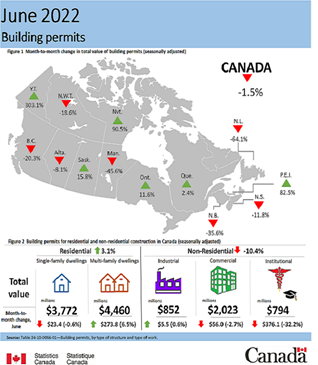Non-residential slowdowns drive June building permits down
A sharp drop in non-residential construction activity across the country, and in British Columbia in particular, forced down the value of building permits in June.
 The latest data released by Statistics Canada shows a drop of 1.5% – to $11.9 billion – in building permit values for the month. The value of permits issued in the non-residential sector fell by 10.4% to $3.7 billion. This was after posting its second-highest monthly value in May.
The latest data released by Statistics Canada shows a drop of 1.5% – to $11.9 billion – in building permit values for the month. The value of permits issued in the non-residential sector fell by 10.4% to $3.7 billion. This was after posting its second-highest monthly value in May.
A lot of the non-residential sector’s loss was due to decreases in British Columbia's commercial and institutional components.
Across the country, commercial-sector permit values dropped 2.7%, with declines in eight provinces. In contrast, Ontario saw an increase of 37.5%, driven by a permit for a large office building in Toronto.
Intentions in the institutional component, meanwhile, fell 32.2%, following strong growth in May resulting from a large hospital permit in British Columbia. The value of industrial permits rose by 0.6% nationally, and by a whopping 206% in Saskatchewan, where construction began on a new power plant in Moose Jaw.
Ontario pushes up residential sector
The value of residential permits, meanwhile, increased 3.1% to $8.2 billion nationally in June.
The value of multi-family building permits increased 6.5%, with Ontario (+24.8%) leading the way, due to several apartment buildings under construction in Mississauga. Overall, 15 out of the 20 highest value permits submitted across all sectors were for apartment or condo buildings.
Construction intentions in the single-family home component declined 0.6% due to large decreases in Manitoba and Newfoundland and Labrador. Gains in Ontario (+2.1%) helped to counter these losses.
Permit values hit record highs in Q2 2022
In the second quarter of 2022, the total value of building permits increased 2.8% from the previous quarter to $35.9 billion. Both the residential and non-residential sectors reported gains.
The residential sector increased 7.2% for the quarter, with gains in the value of both single- (+5.0%) and multi- (+9.3%) family permits. British Columbia led the growth, followed by Alberta and Ontario.
The number of new residential units rose 6.0%, after a decline of 7.8% the previous quarter. This incline was driven by a rebound in the multi-unit component (+8.9%).
The non-residential sector decreased 5.1%, following a strong first quarter. The institutional component (-21.9%) dragged down the sector, following the issuance of two large hospital permits in the last quarter. Commercial permits declined 0.6%, while industrial permits posted gains of 11.4%.








